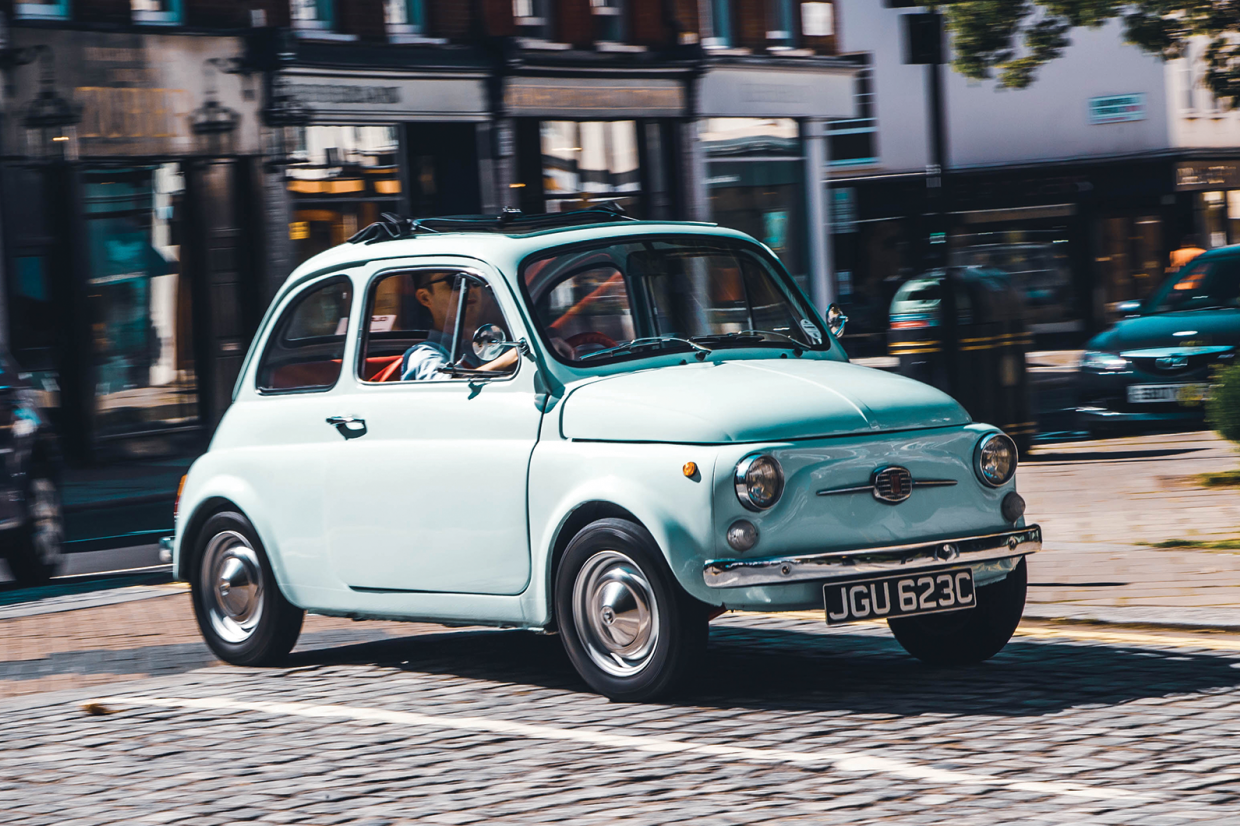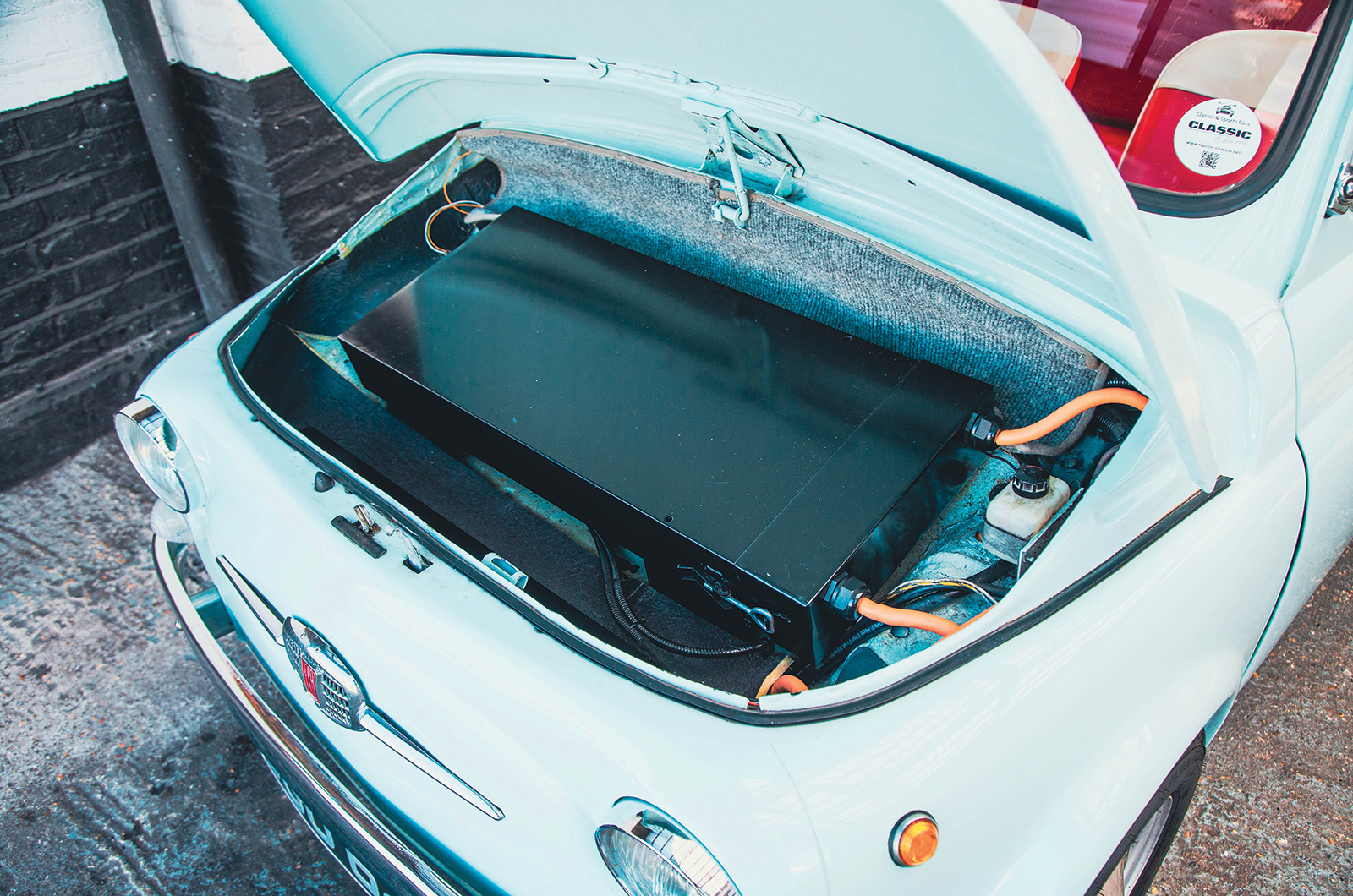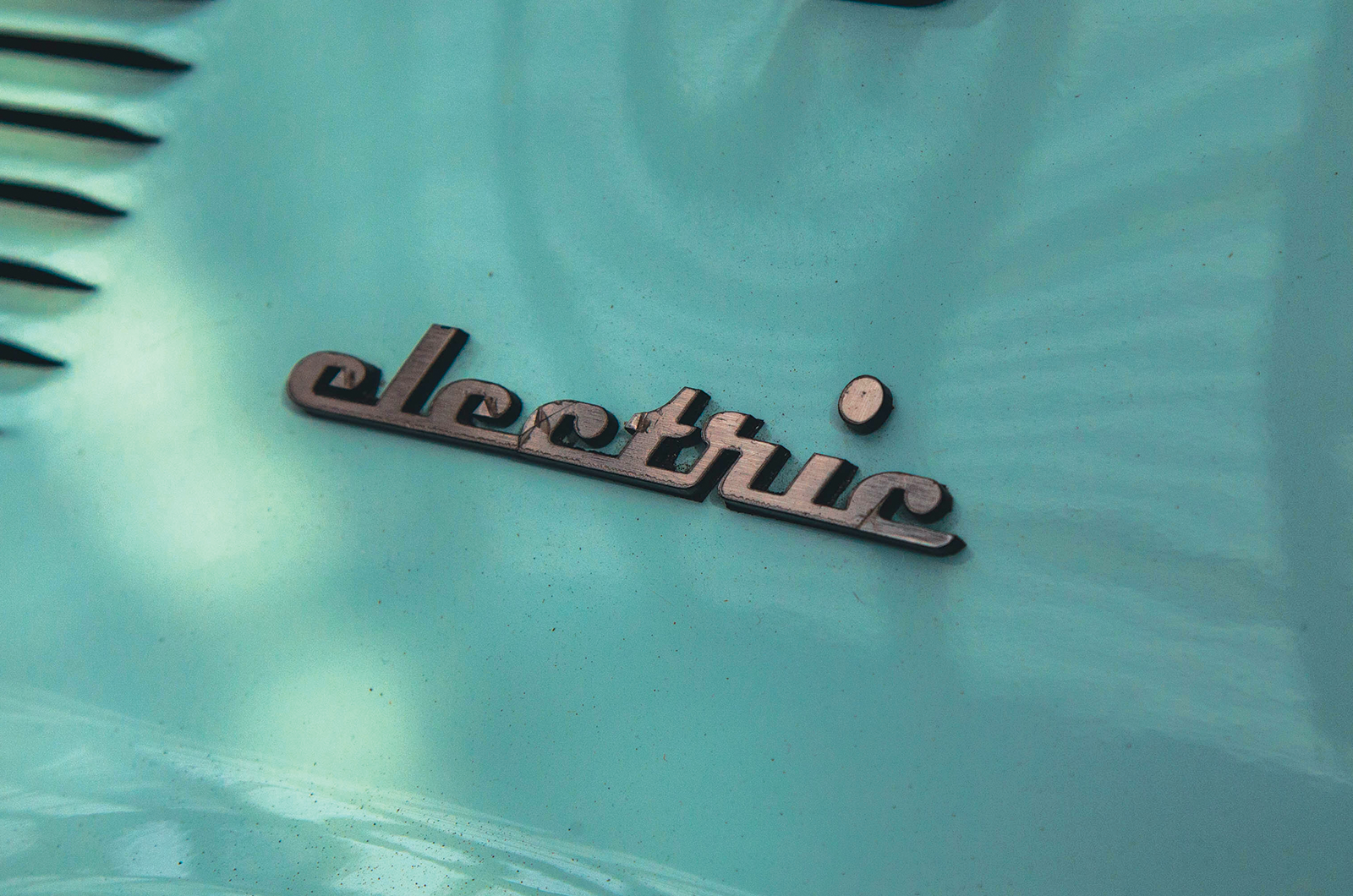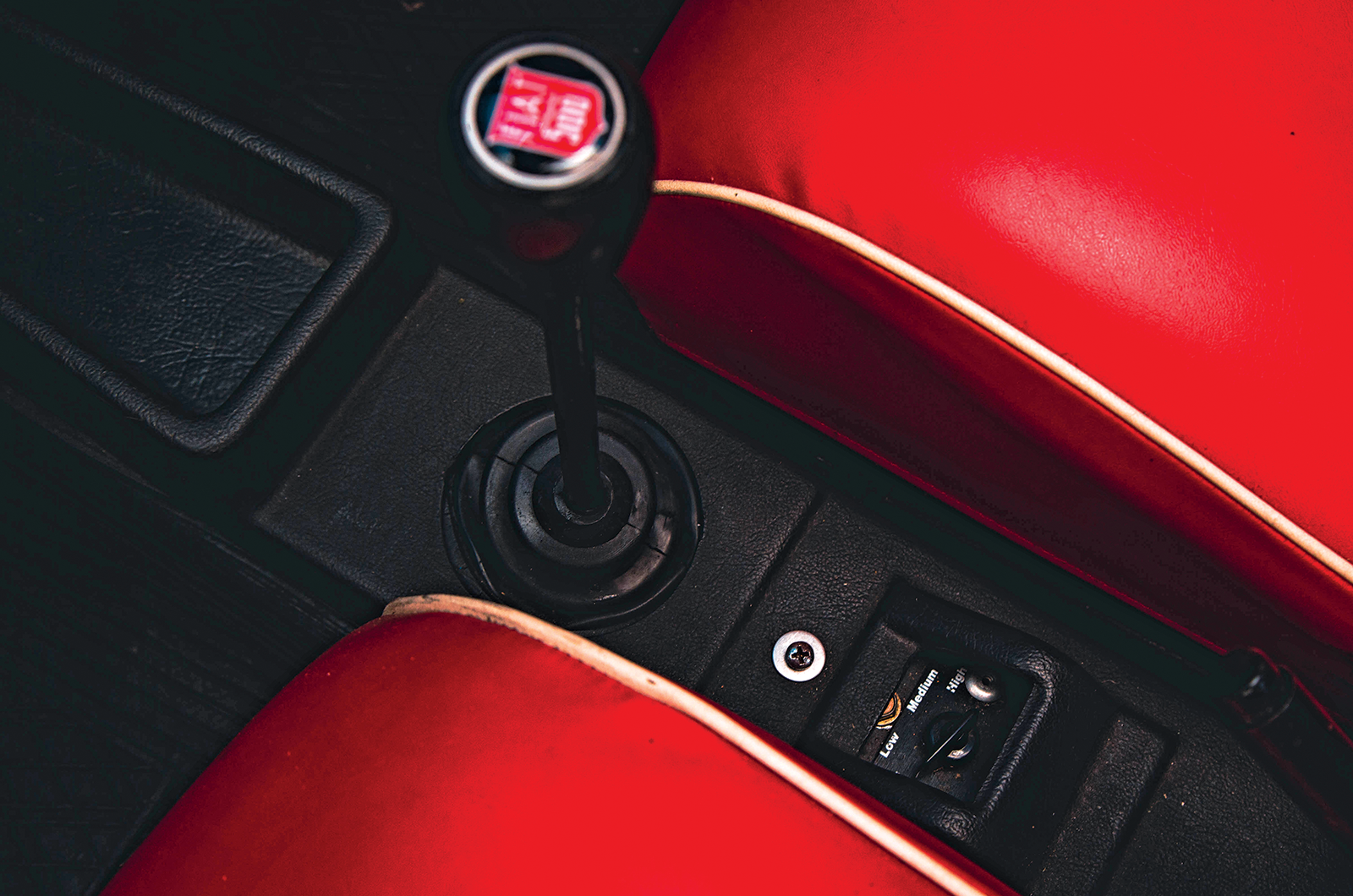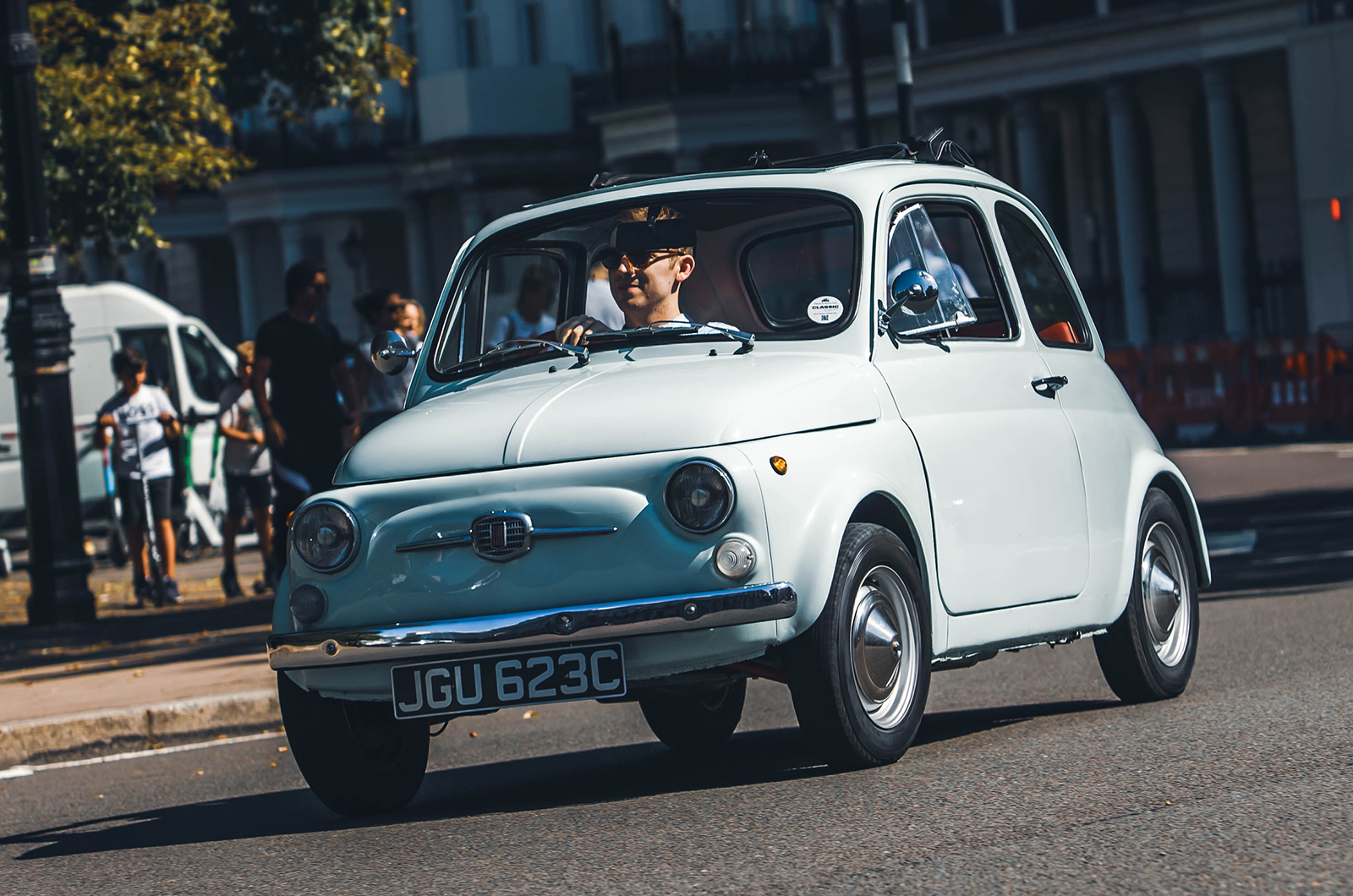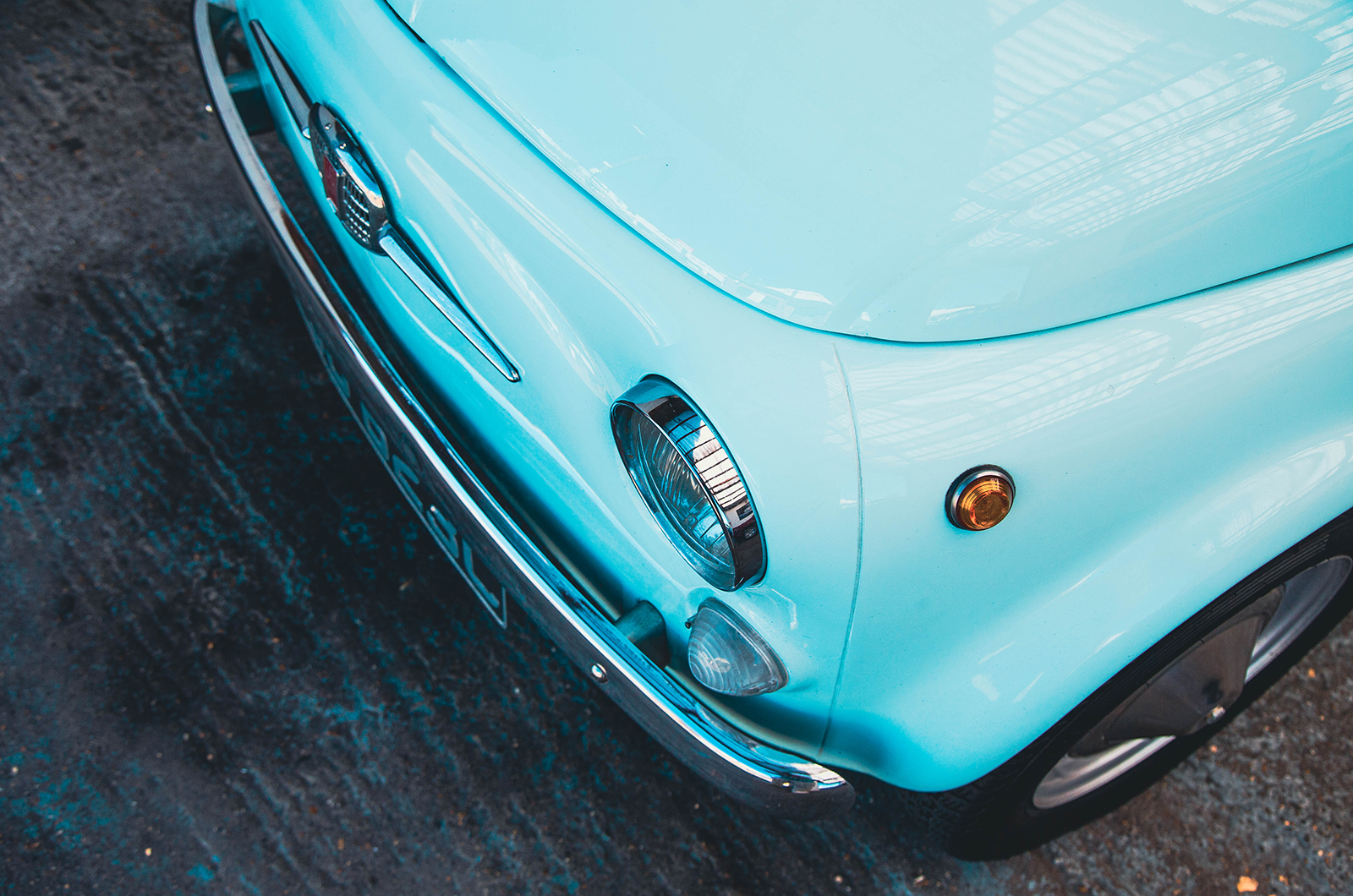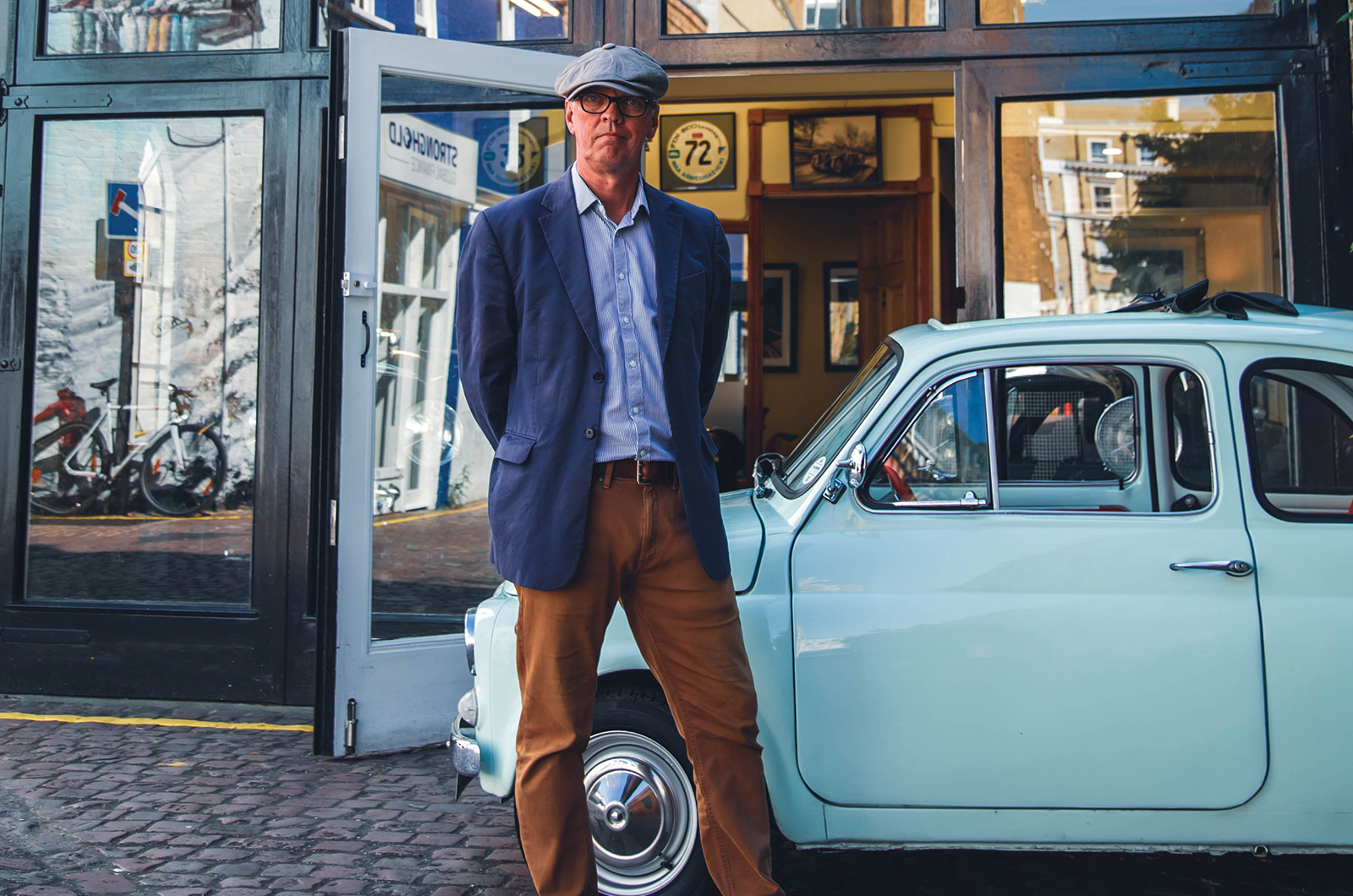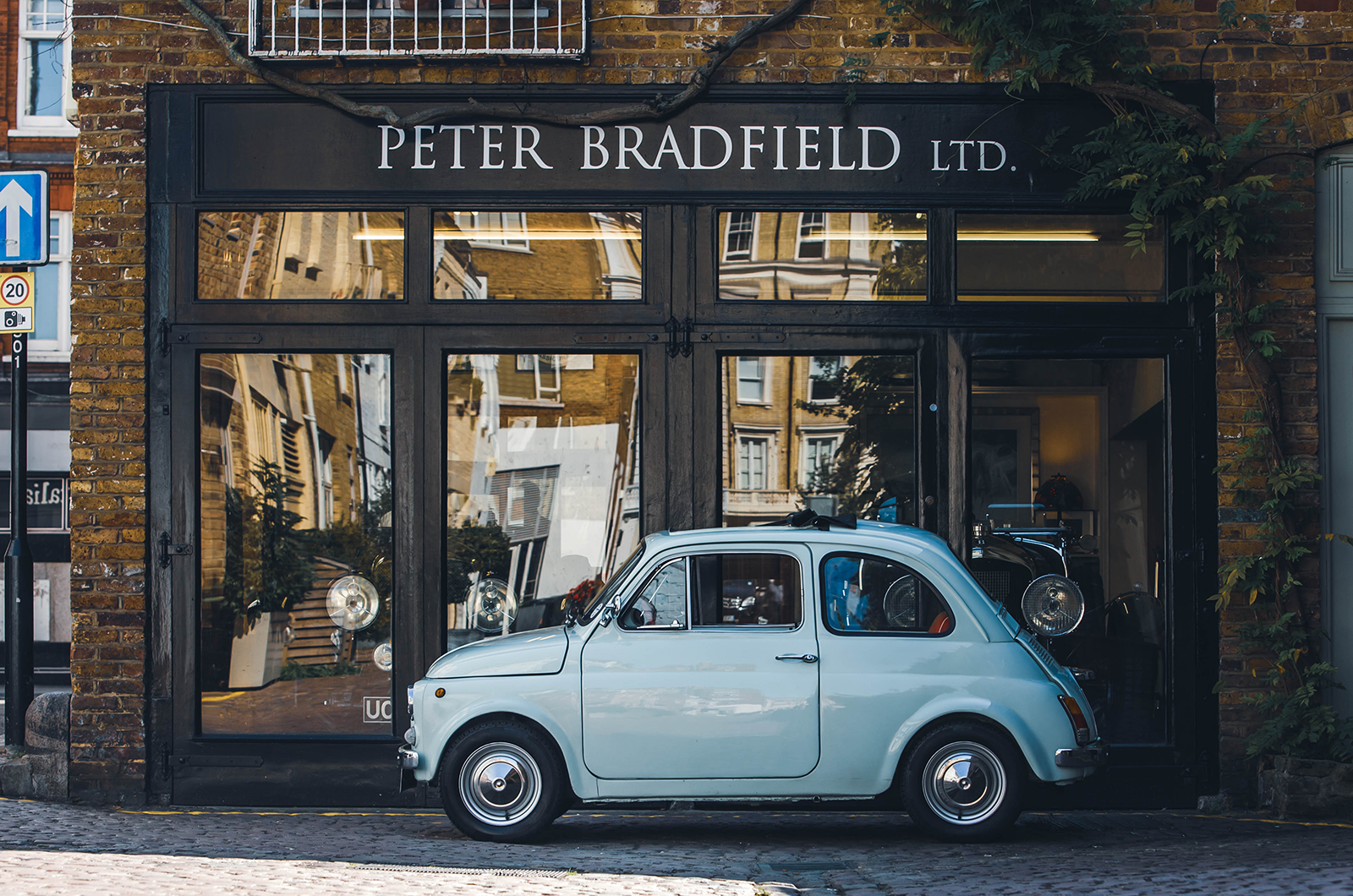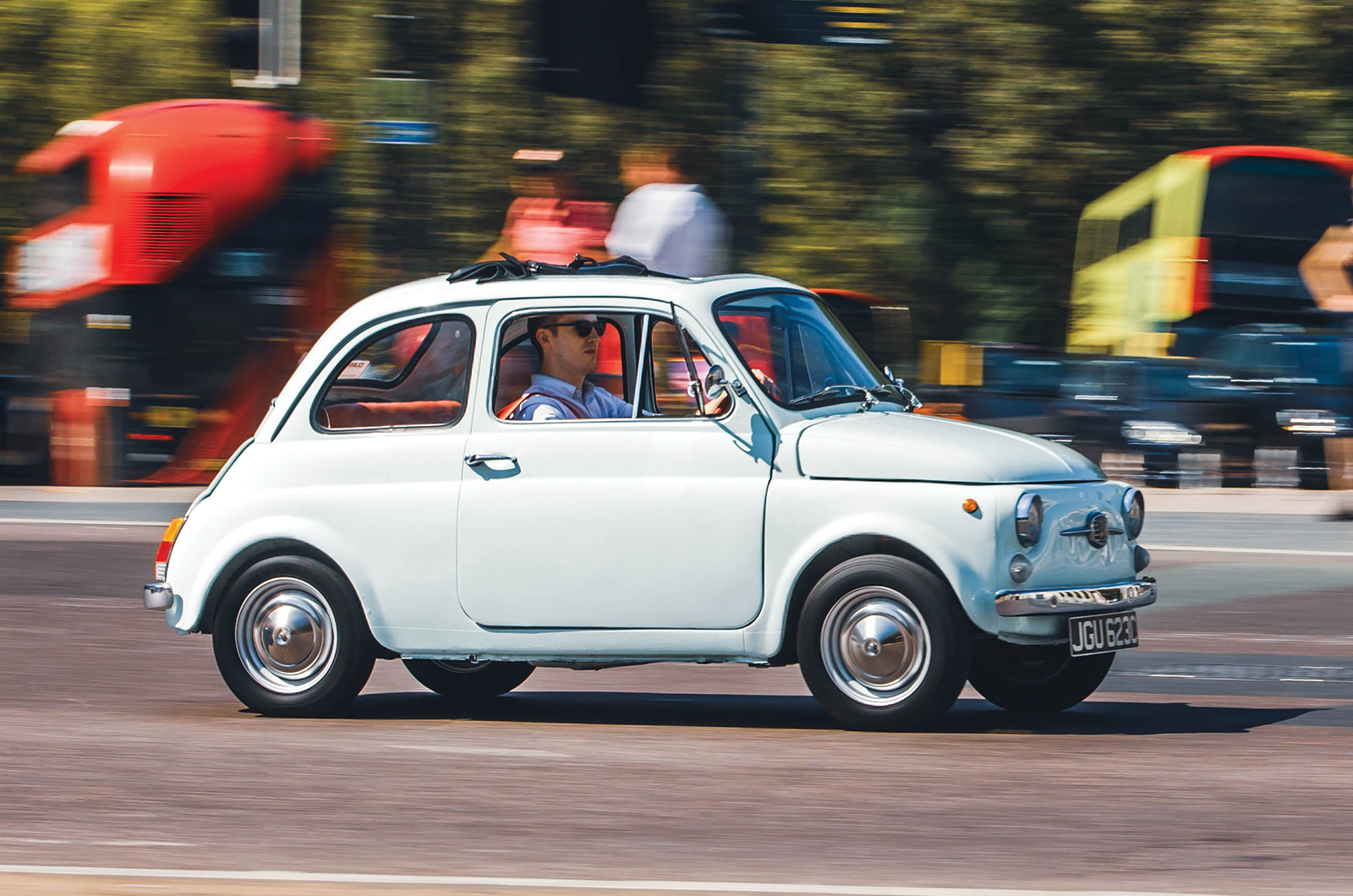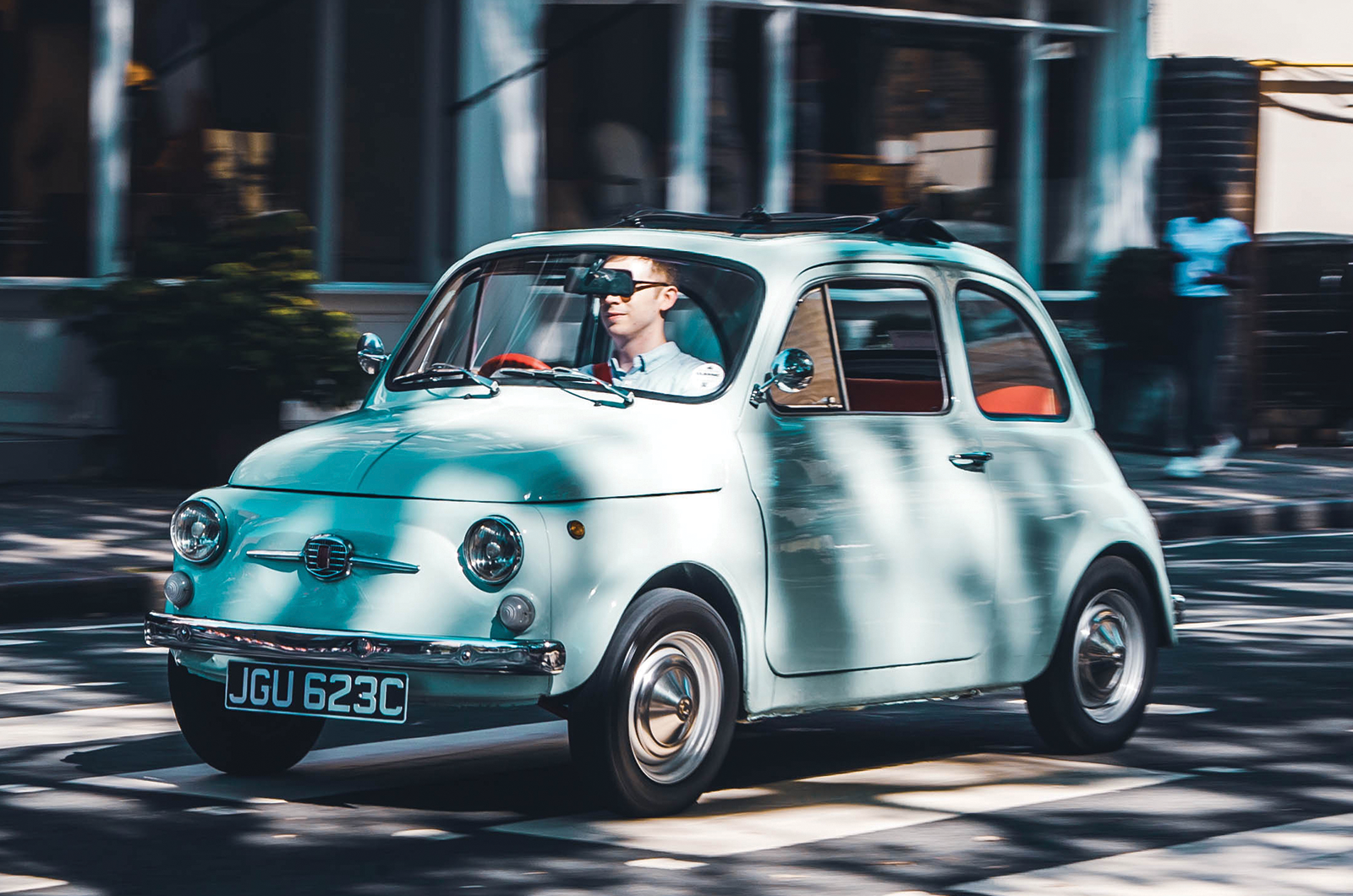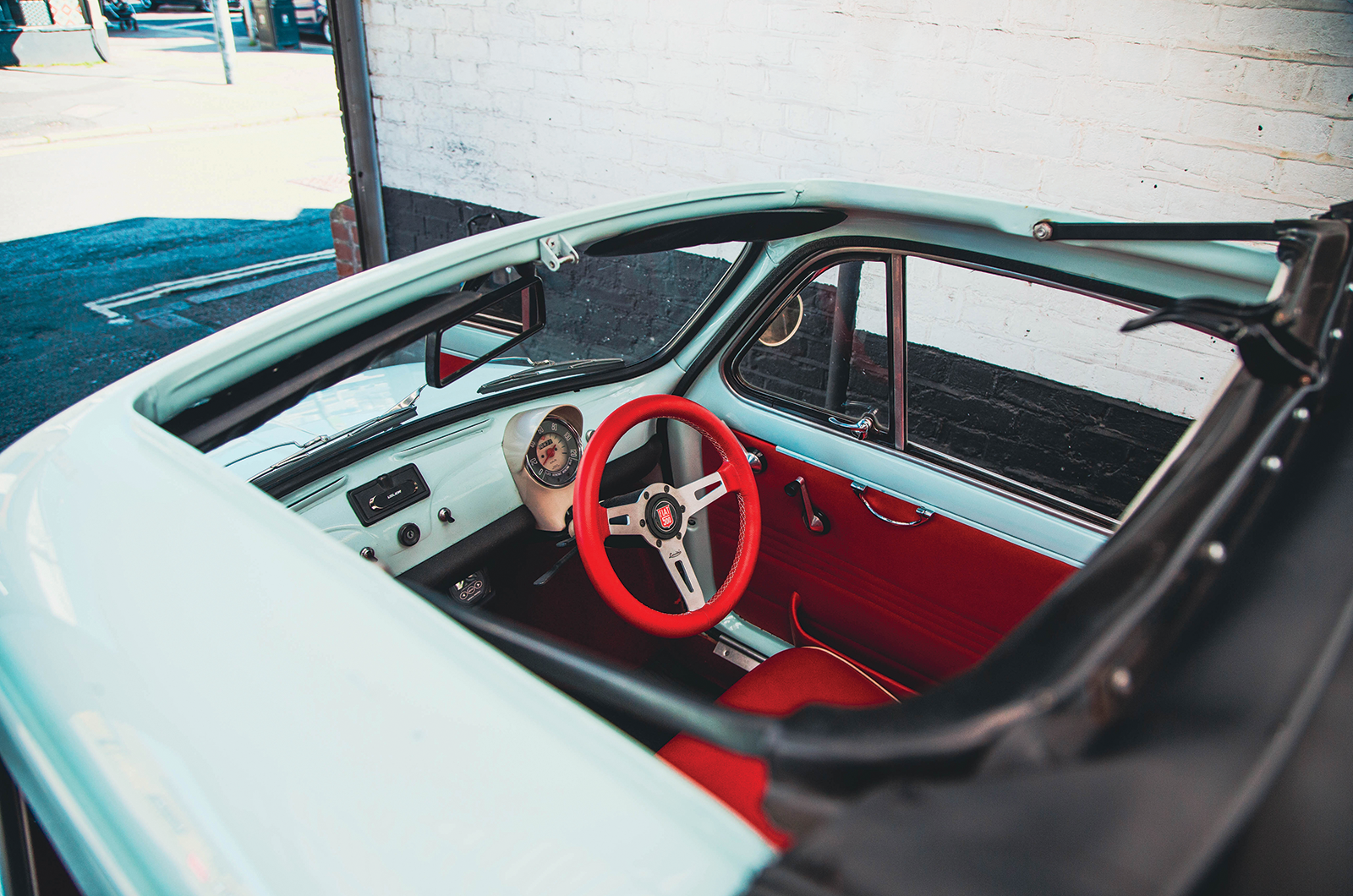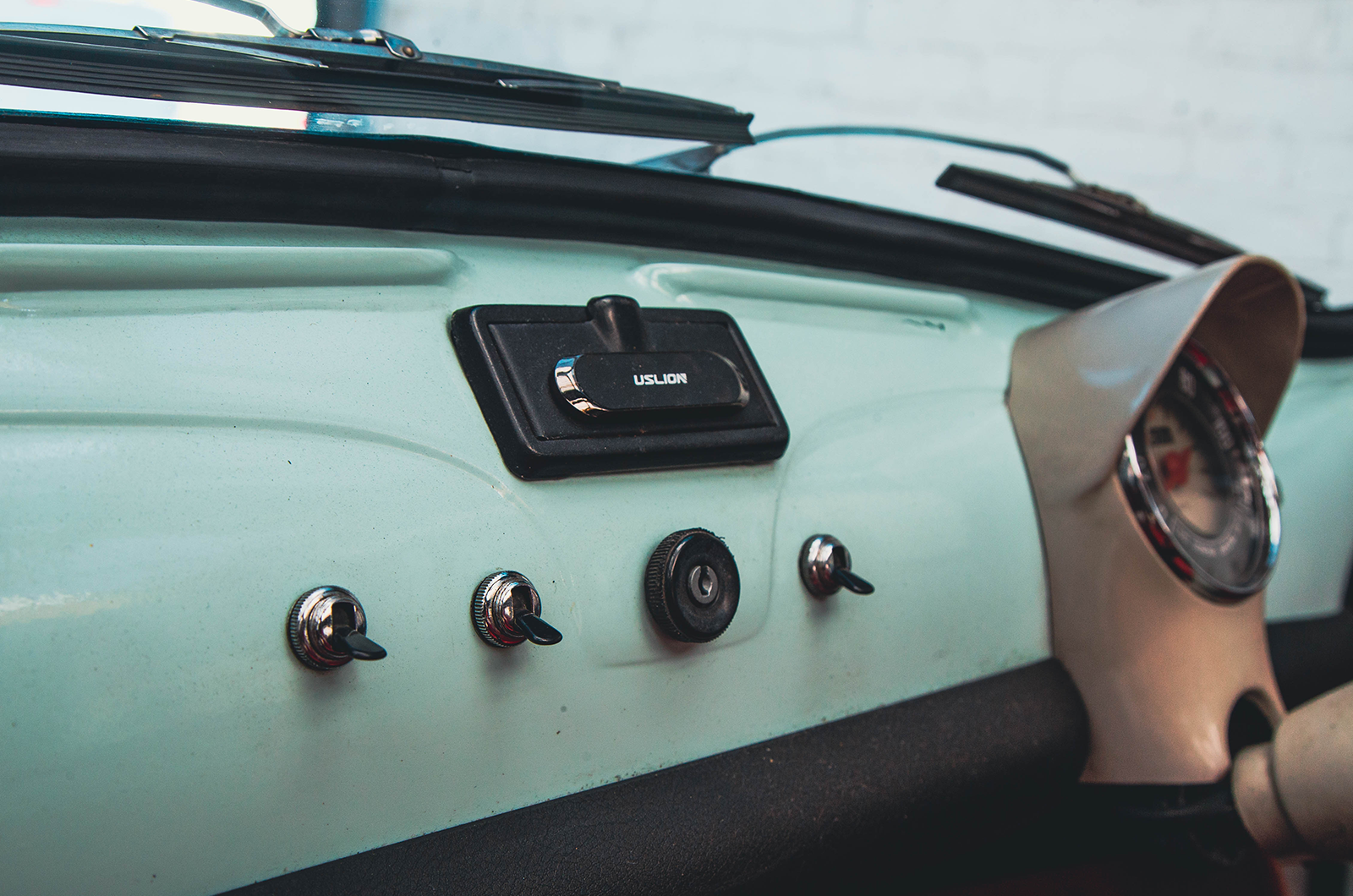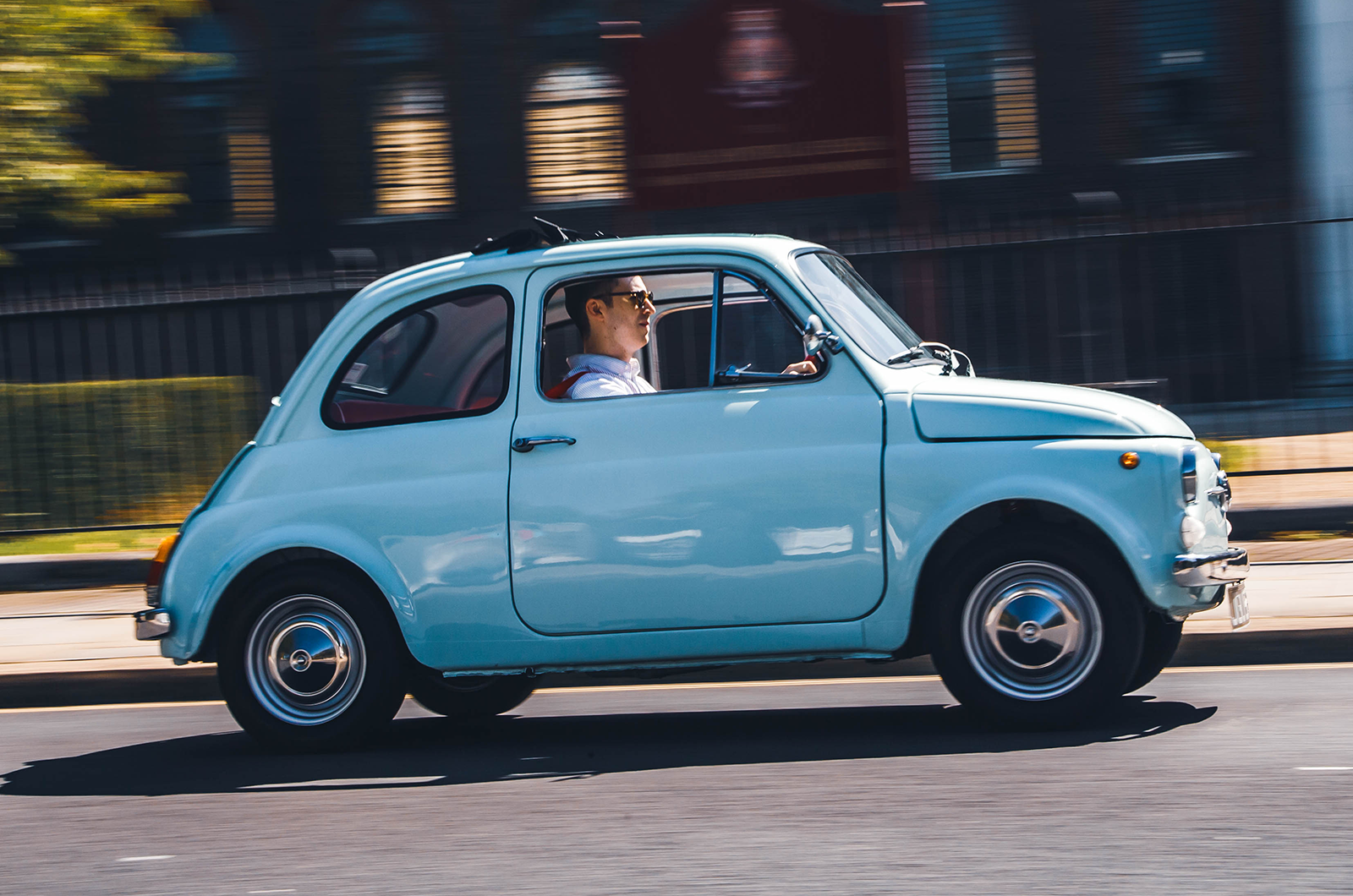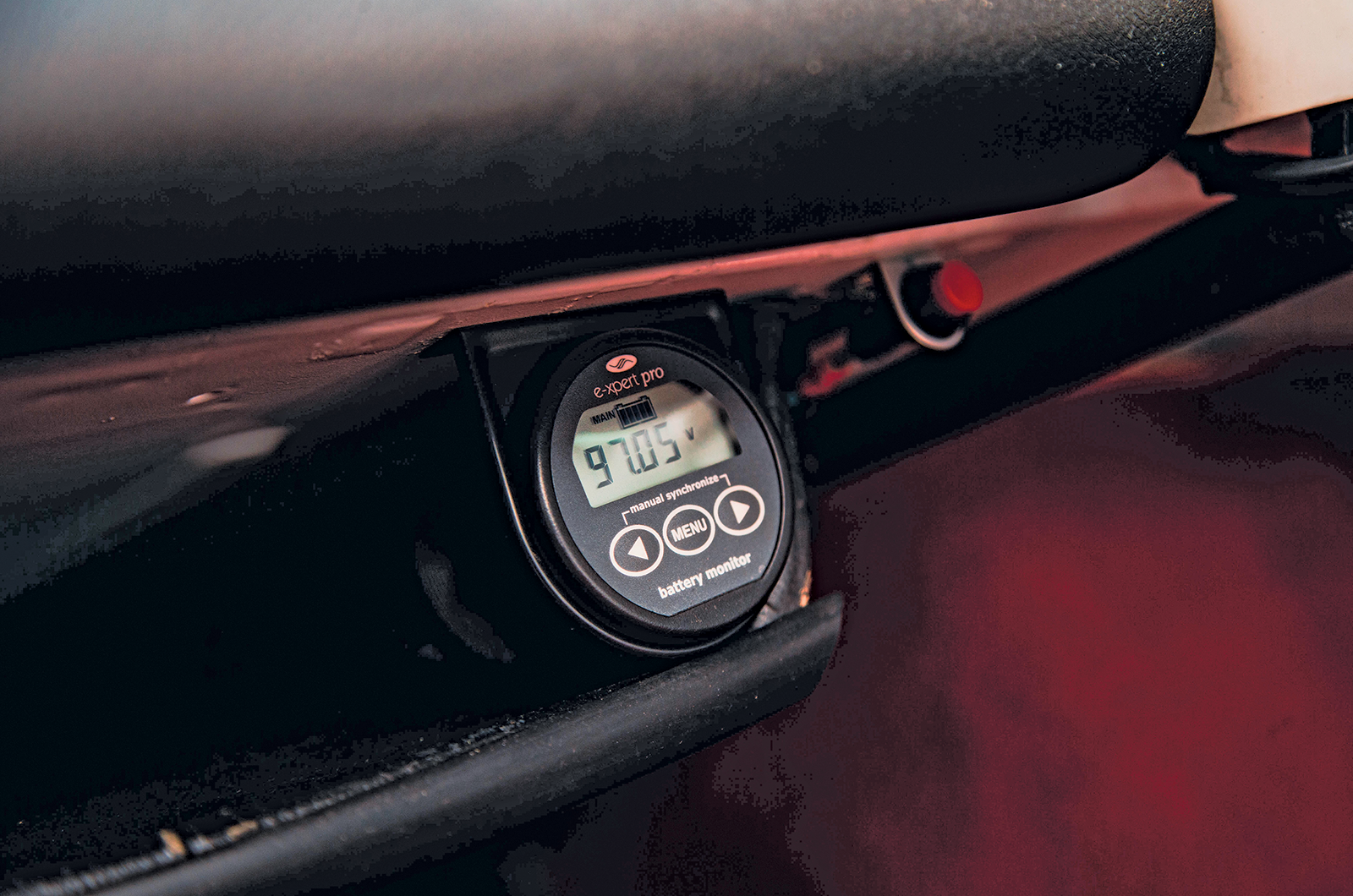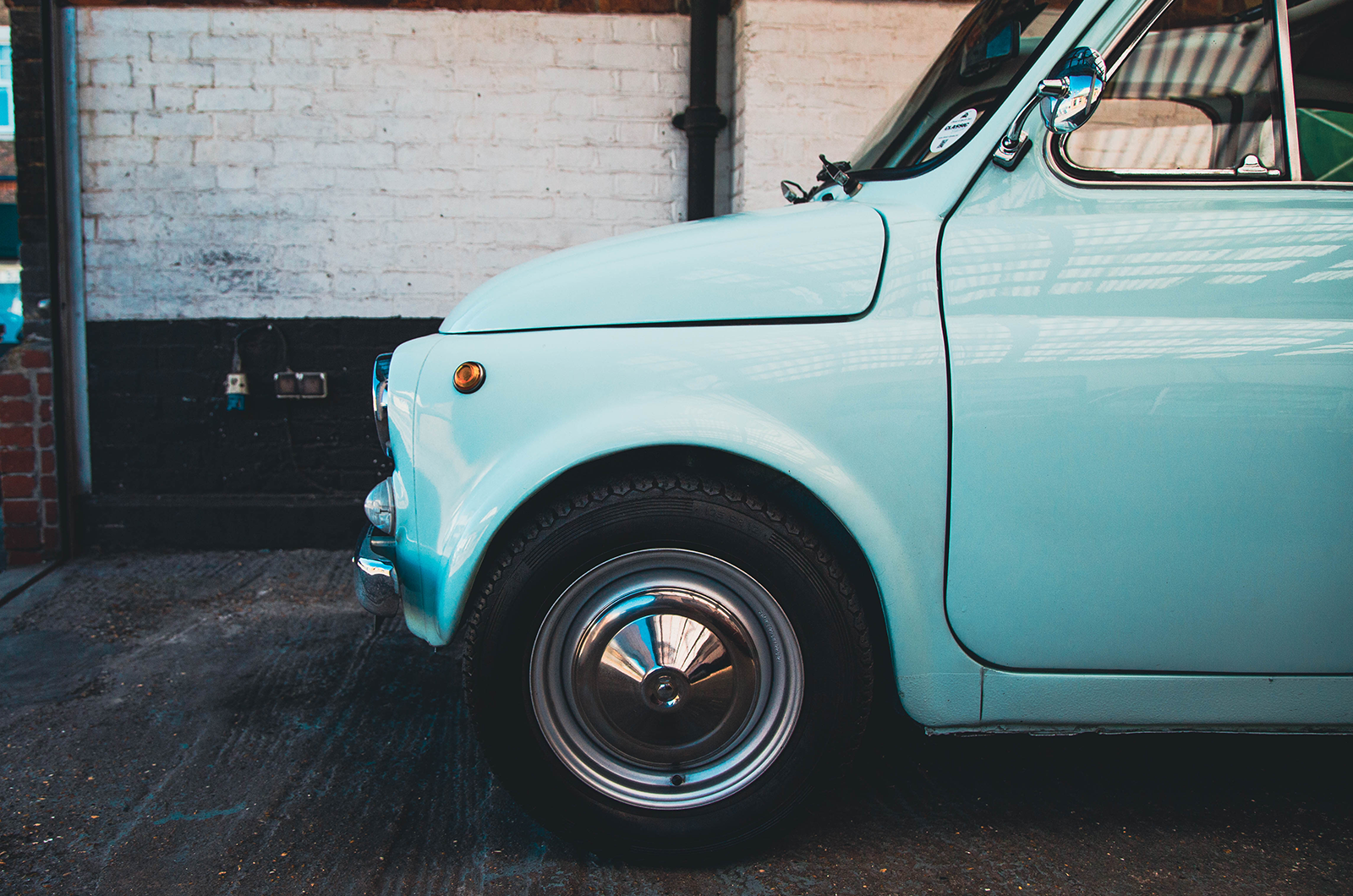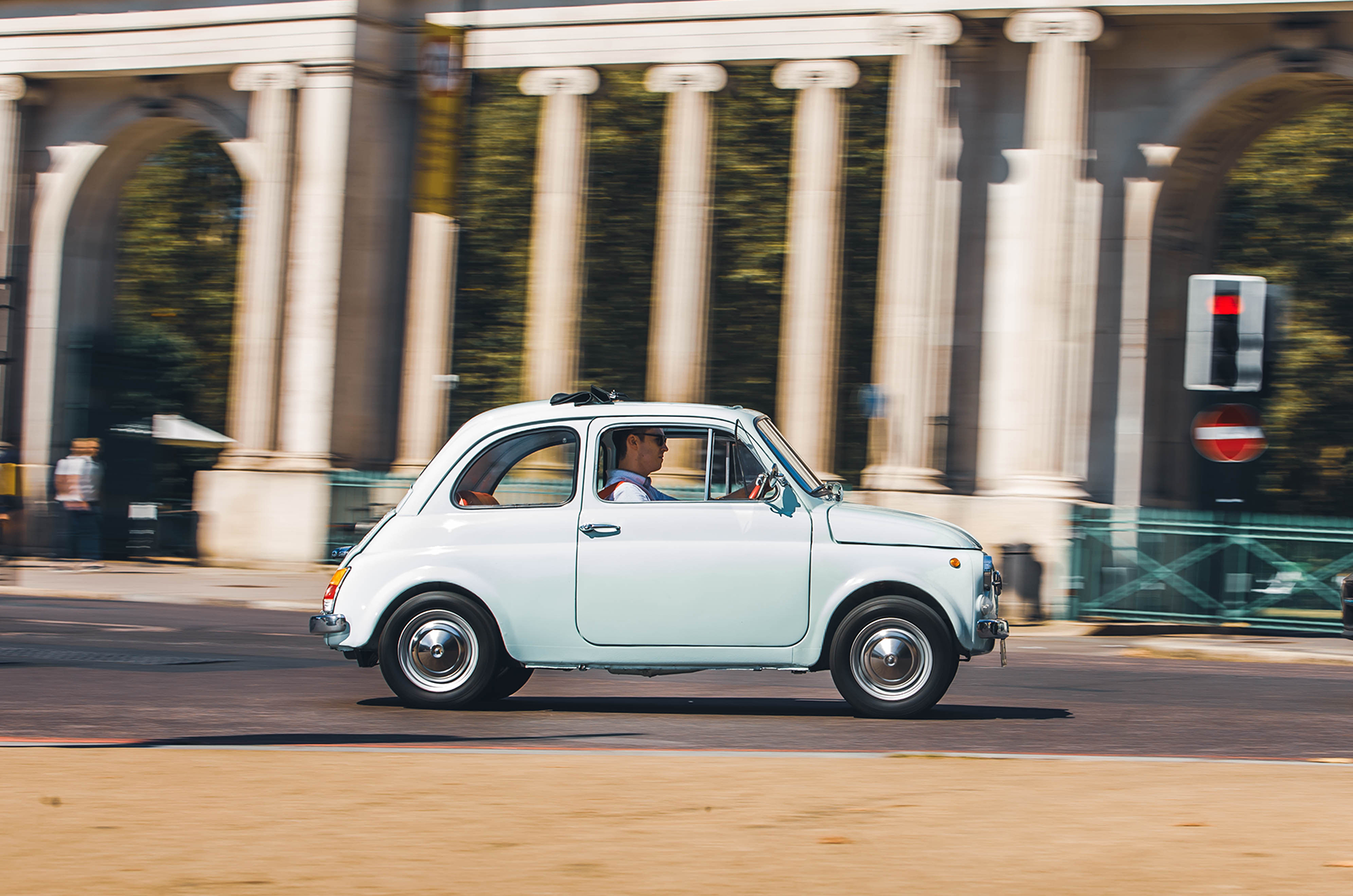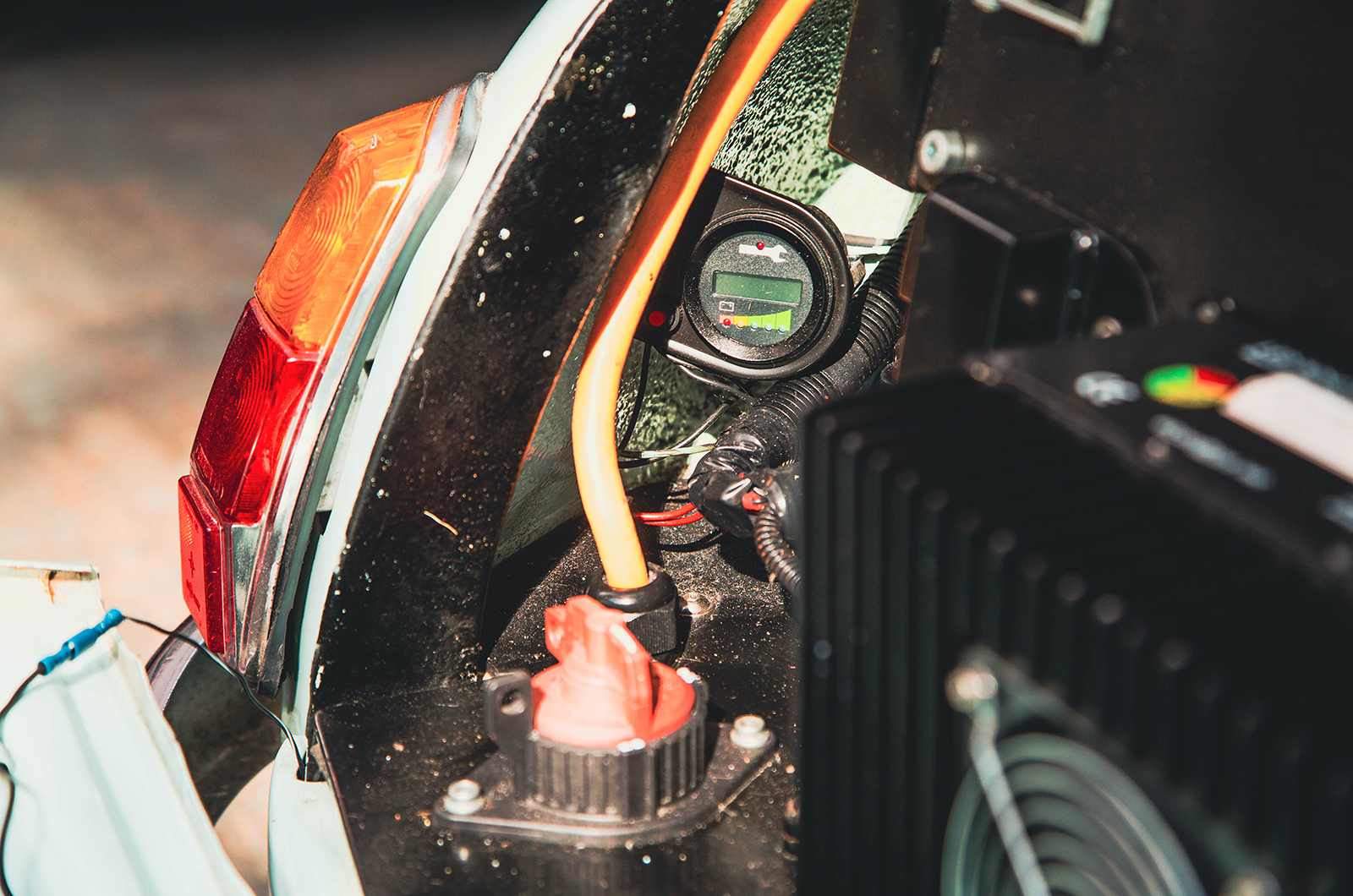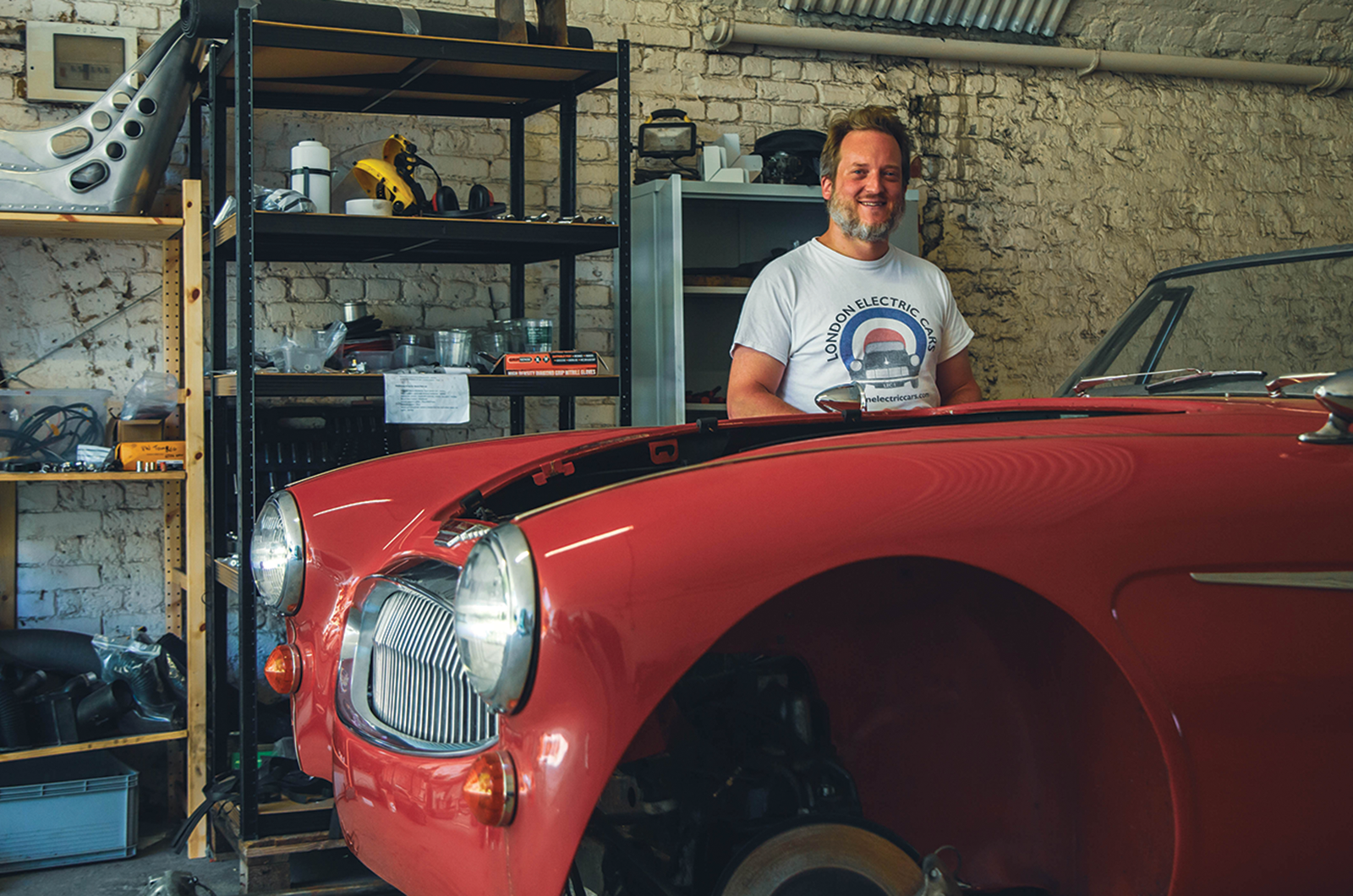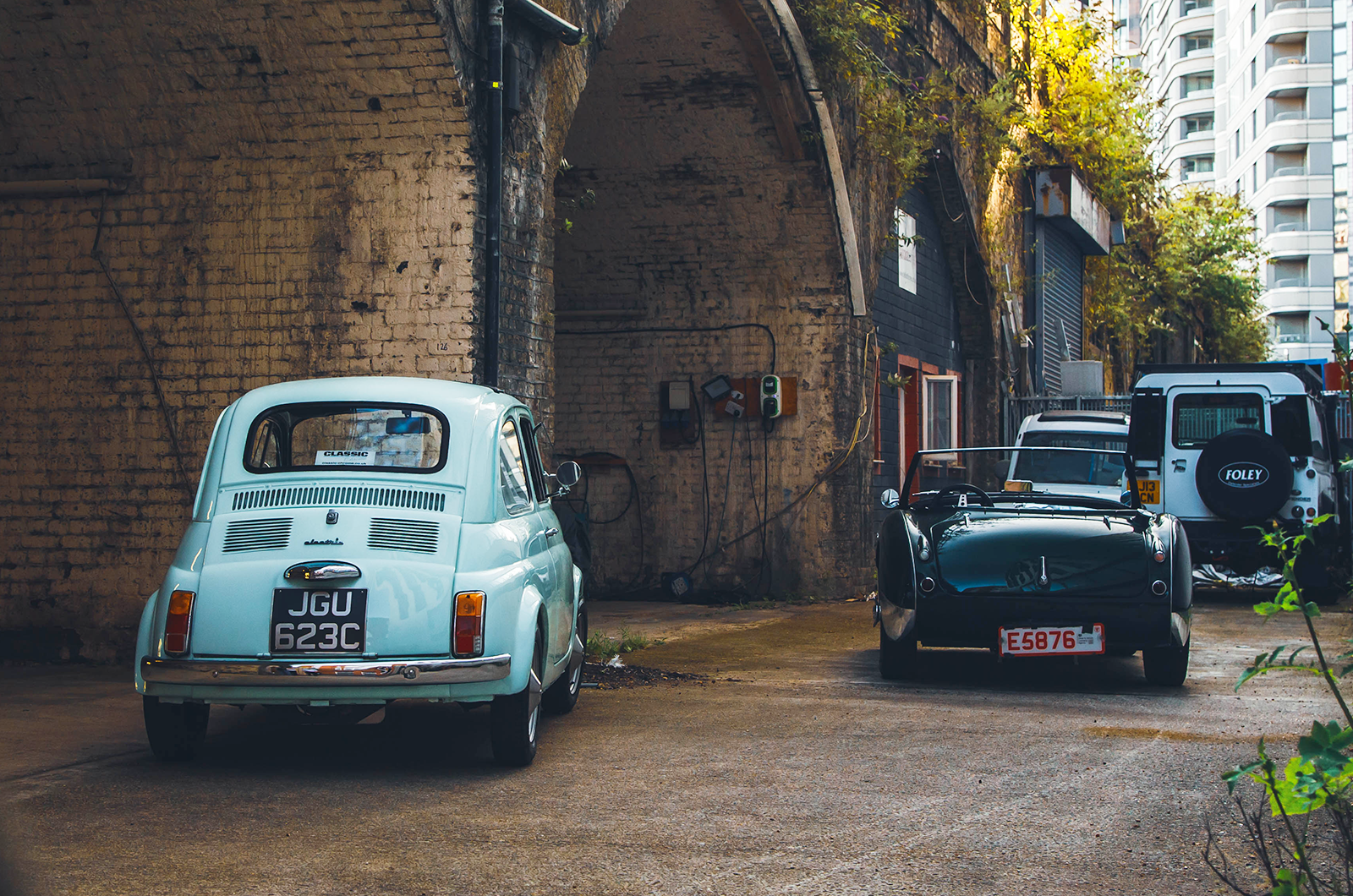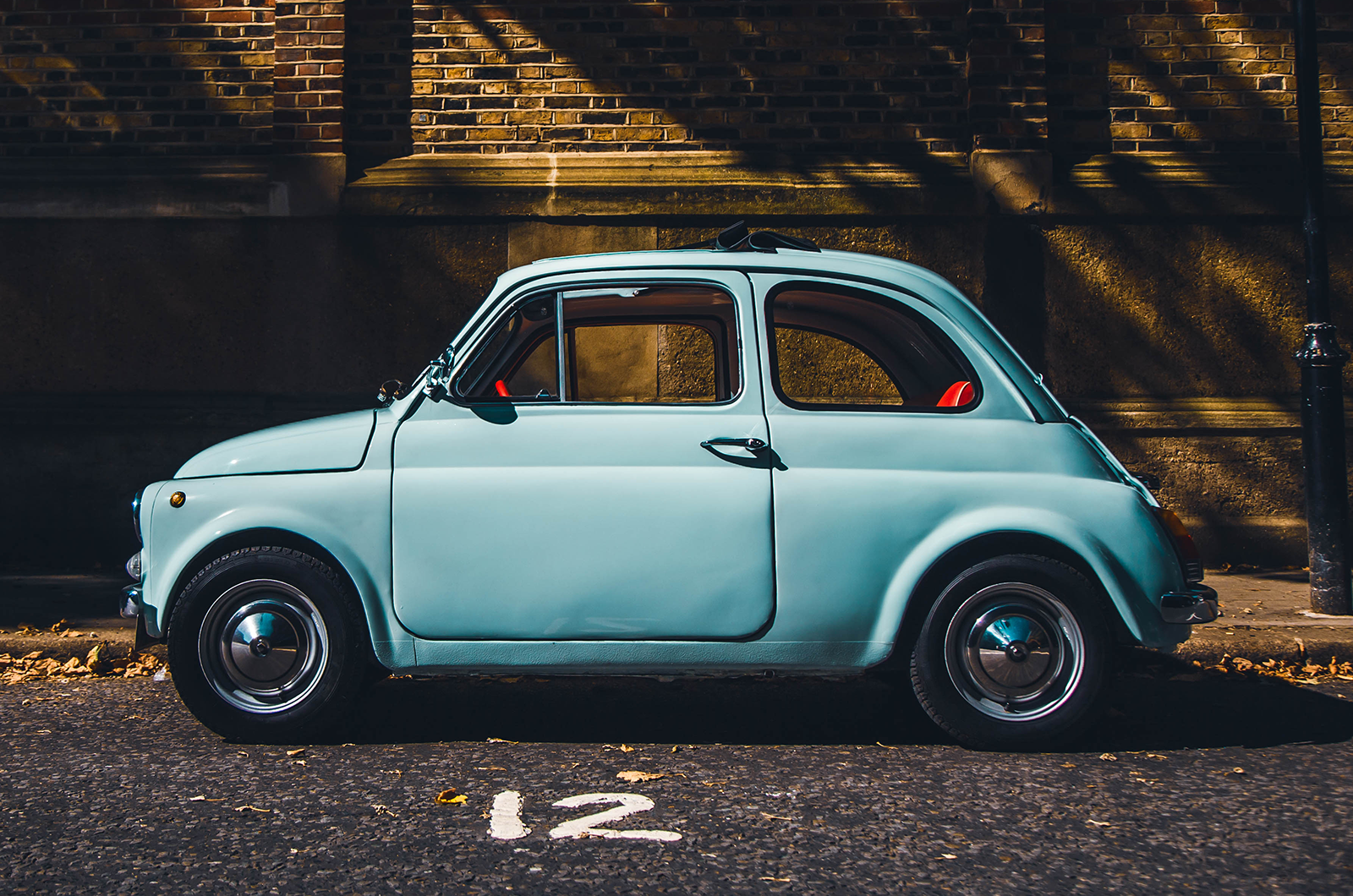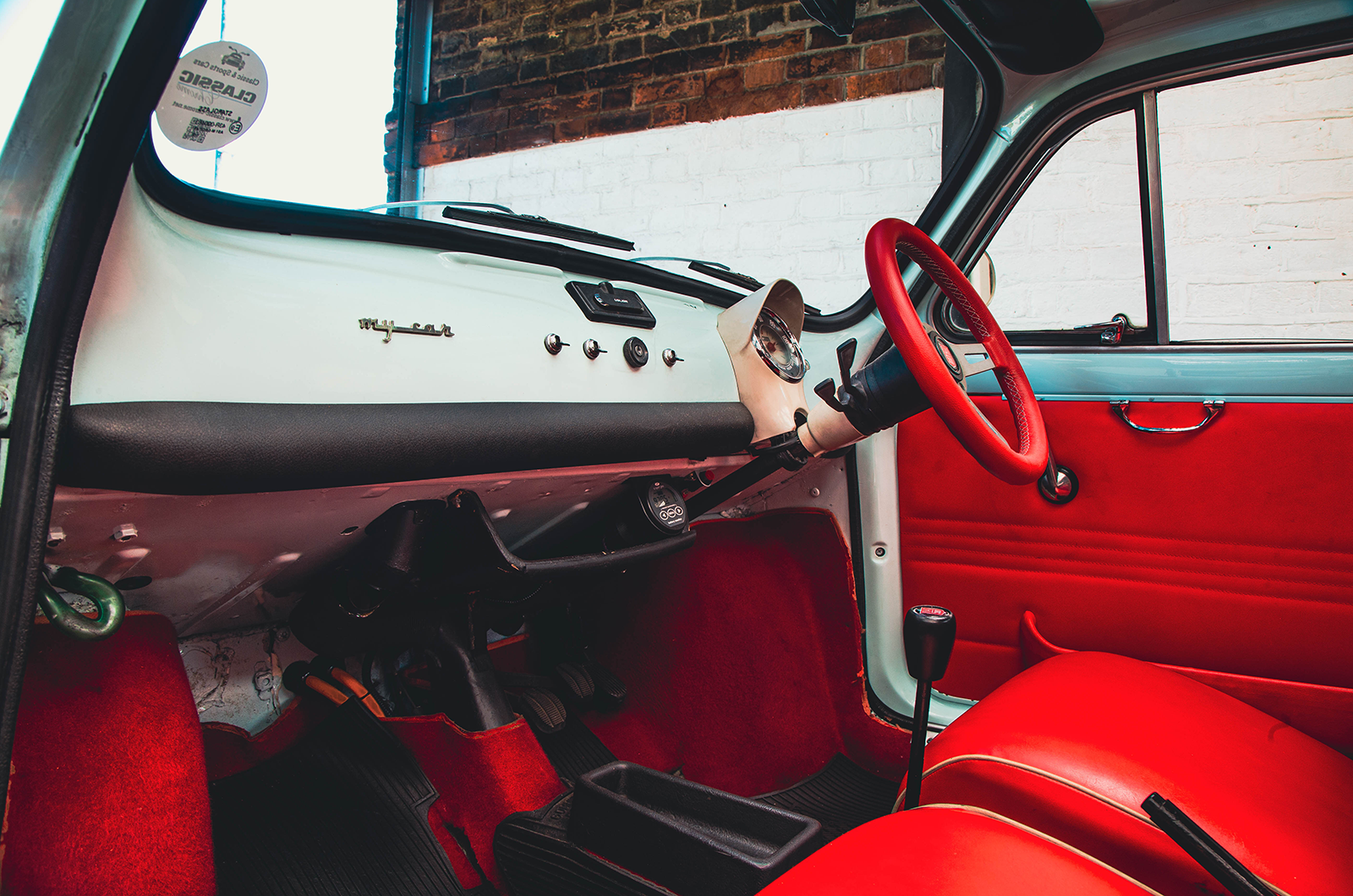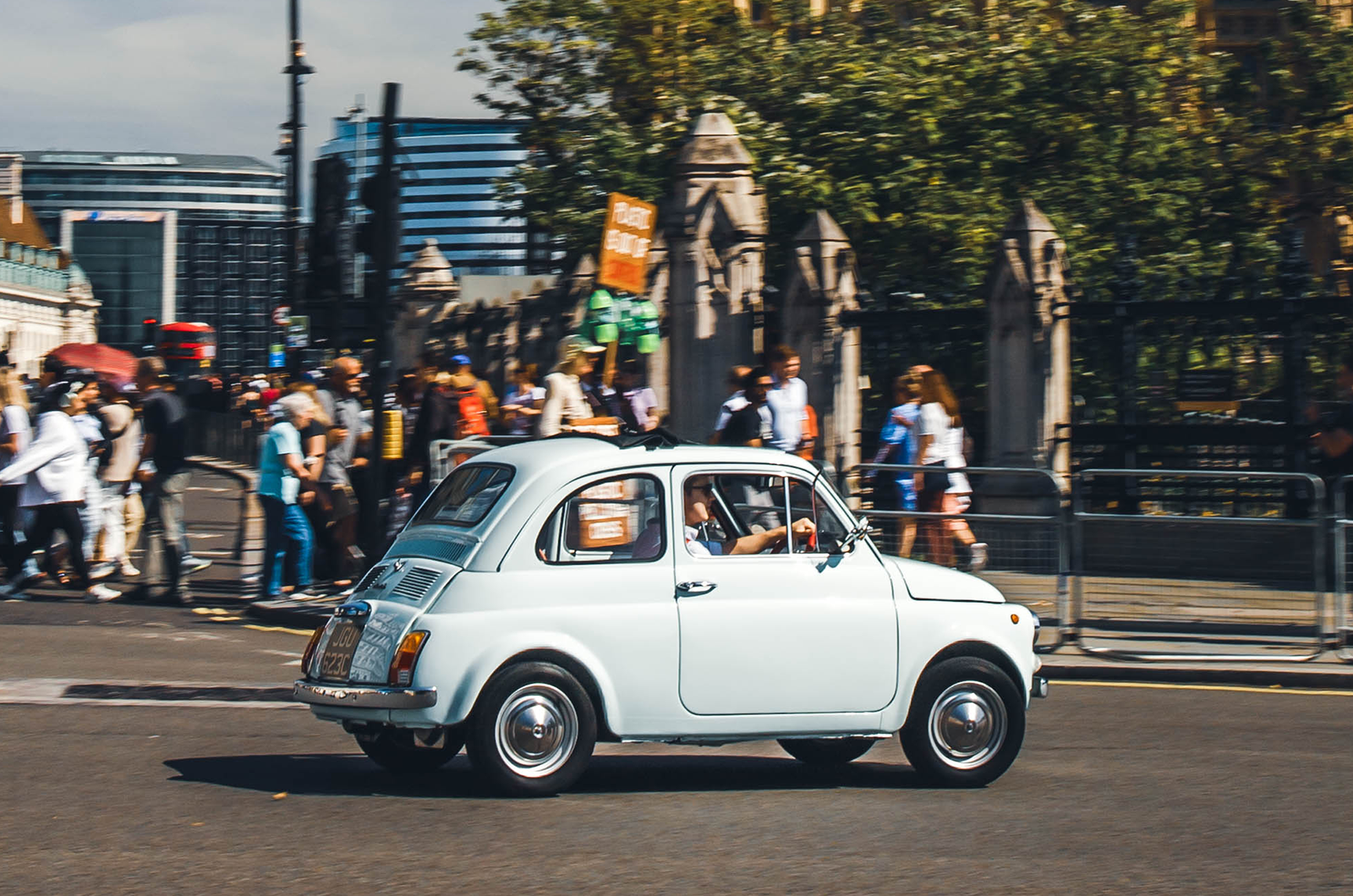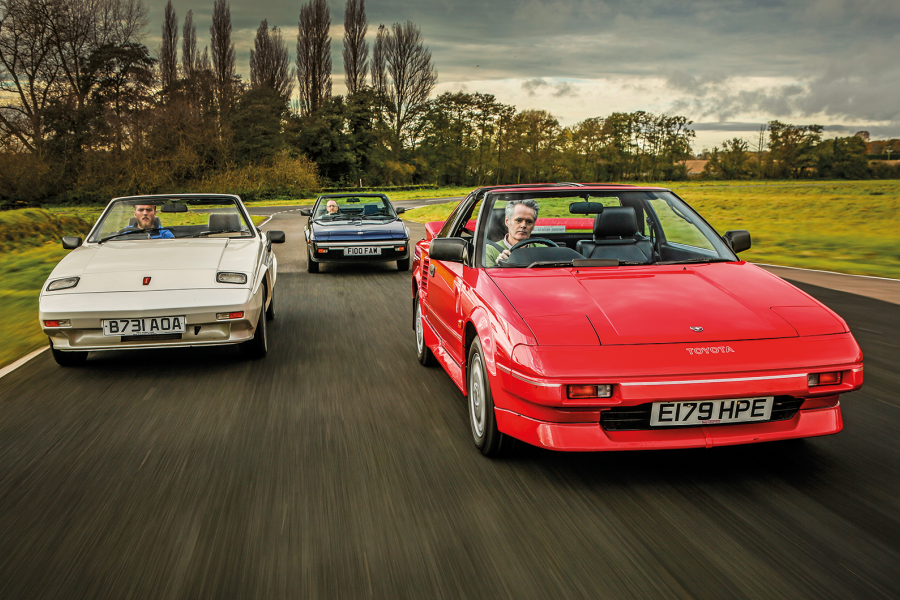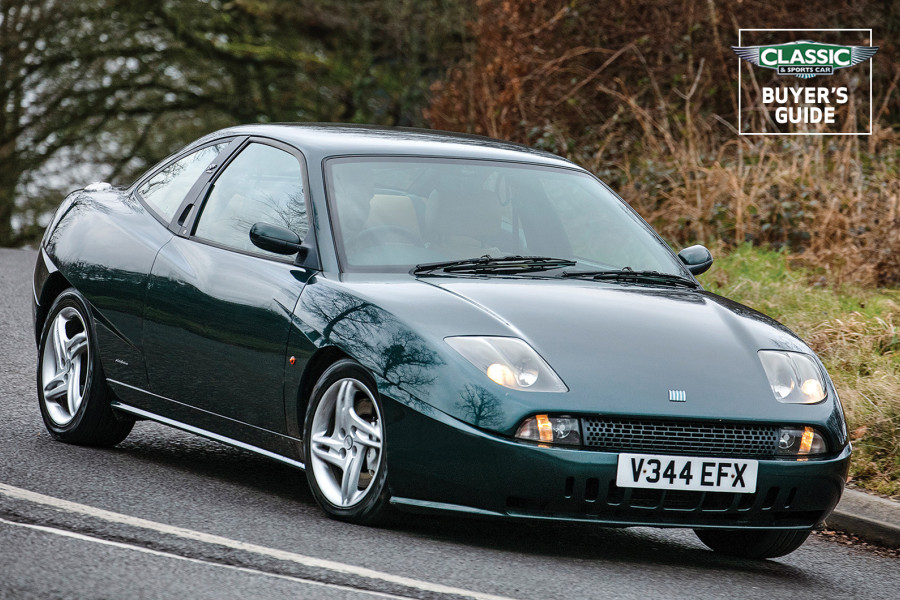“I don’t think people will necessarily come to me looking to sell their electric classics, but I always say that if the price is right, I can sell anything!”
The electric Fiat 500 provides a classic motoring experience with a modern twist
Turning back out of the cobbled mews and heading towards Westminster, the Fiat gets to stretch its legs through the quiet, embassy-lined streets of Belgravia and zips around Belgrave Square’s wide, unmarked loop.
It’s the closest we’ll get to Rome’s famously anarchic Piazza Venezia, where 500s traditionally earn their spurs – and dents.
There’s not much room to stretch out inside, and without any need to push the clutch pedal, the constant hovering of your left foot becomes tiresome.
In the absence of an engine, gearbox whine becomes the loudest sound in this electric Fiat 500
Once back in bumper-to-bumper traffic at Parliament Square, however, any desire to use a clutch pedal disappears.
As we make progress of only metres at a time, passing tourists get plenty of opportunities to take photographs of the little Fiat, and we have a couple of conversations at red lights before reaching Westminster Bridge.
It can feel vulnerable in the tiny 500 when the roads get tighter and you are pushed up against a bus, but you’re also let out of junctions and given space to change lanes with unparalleled regularity.
Room for a small one?
Our final stop is beneath the arches of Waterloo Station, where one of Britain’s first classic EV conversion specialists, London Electric Cars, is located.
Founder Matthew Quitter is, unsurprisingly, an evangelist for converting classics to electric power, but he’s quick to admit the challenges.
“When I started London Electric Cars, the goal was to create affordable EV conversions,” he says.
“It was a huge mistake. There’s no benefit in racing to the bottom. I had this idea you could do it for under £20k. No chance. Just no chance.”
Price is the biggest obstacle when converting a classic car to electric power
The amount of labour involved in any EV conversion is significant, explains Matthew, but more than that, it is the R&D involved in converting a model for the first time.
“We did a Morris Minor Traveller and put a Nissan Leaf motor in it, which more than doubled the power, quadrupled the torque and added 350kg of weight,” says Matthew, recounting one of his early mistakes.
“The chassis, the springs and the brakes were all struggling, and you had to remove a battery pack just to change a headlight.
“So we had to start again with a smaller motor and battery pack.”
London Electric Cars founder Matthew Quitter has learned that classic EV conversions can’t be done on the cheap
As a lifelong classic car nut who owns an electric-converted Minor and a petrol-powered Triumph Spitfire, it became clear to Matthew that focusing on classics was the answer given both the passion and the budgets that owners have to look after them.
“We started to get new customers who love how a classic car looks, but hate them for their lack of reliability and their fumes,” he says.
With rising component costs also having an impact, Matthew now quotes £100,000 or more for a conversion on a model he’s never tackled before.
But a basic update on a more familiar car, such as a Morris Minor, a Mini or a Land-Rover, starts at £30k.
‘Our’ electric Fiat 500 next to an Austin-Healey at London Electric Cars
It’s not just costs that have changed in the past five years, however: the DVLA has also become much stricter on the practice.
“They started to get so many enquiries that they freaked out a bit,” says Matthew.
“For a short period of time, they just shut it all down. Now they send an engineer.”
As a result, any electric conversion must now be careful not to modify the chassis or monocoque of a car in any way, or it may find its V5 withheld and require re-registering under a ‘Q’ plate.
The Fiat 500 has never struggled with tight urban parking
“All I used to hear was ‘sacrilege!’,” smiles Matthew, “but we’re not doing anything that is so substantial that you couldn’t reverse it, and with some of the cars we have we’re doing so much restoration work that we are almost turning it back to original form before we convert.”
Pleasingly, Matthew isn’t too high-minded about his conversions, considering himself just the latest in a long line of hot-rodders who have looked to make old cars more powerful and reliable.
“It’s entirely up to the owner, and always has been,” he says. “There are people who will tell you that you’ve ruined a car just for changing the steering wheel.”
This EV-converted classic Fiat 500 is in great condition
Leaving Waterloo and taking the Fiat back to Mortlake is just a case of following the South Circular, but the route tests the car’s ride.
The 500 felt composed north of the Thames, with the extra weight taking away the bounciness of the standard car.
But the poor surfaces south of the river reveal there’s only so much you can do with limited suspension travel and small wheels: big potholes or sunken manhole covers are spine-shattering, and best avoided.
Belgrave Square in London provides entertaining respite in the nimble Fiat 500
After a few hours in the 500, the novelty of its electric propulsion begins to fade, and instead it’s just a Fiat that’s easier to drive, less noisy and less temperamental.
Given that a standard Nuova 500 features an engine even many owners aren’t that keen on, this car seems an ideal candidate for an EV conversion.
The move generally makes far more sense in an urban context – both for the benefits to air and noise pollution, and because of the shorter journeys.
In this trip to Central London and back, the Fiat used just one bar of the four on its battery-charge indicator – and that was with plenty of back-and-forth for photography.
Electric classic cars have their place in an ever-changing world
For many classic car enthusiasts, including me, an electric-converted classic doesn’t quite scratch the itch for evocative historic motoring if it were the only old car in the garage.
But as part of a small fleet of classic cars, I can definitely see the sense in it.
It might not be that distant in the future when petrol becomes a lot more difficult to buy and more expensive – maybe even limited to keeping a home supply in a 45-gallon drum.
So, a two-car garage of an internal-combustion-engined classic to savour the joy of petrol power and an electric one in which to do the daily grind? Yes please.
Images: Jack Harrison
Thanks to: Classic Chrome; Peter Bradfield; London Electric Cars
Enjoy more of the world’s best classic car content every month when you subscribe to C&SC – get our latest deals here
READ MORE
Future classic: Fiat 500
London ULEZ: 8 things classic car drivers need to know
London ULEZ expansion: the threat to modern classic cars
The Amsterdam Job: the story of an epic classic Mini advert
Charlie Calderwood
Charlie Calderwood is Classic & Sports Car’s Features Editor
